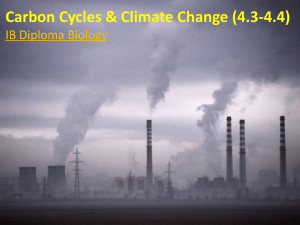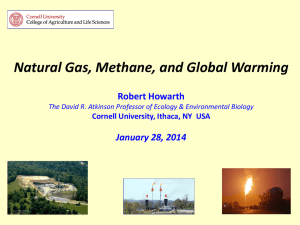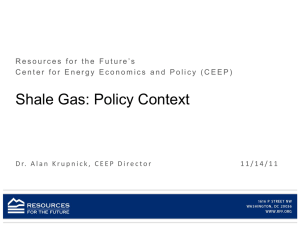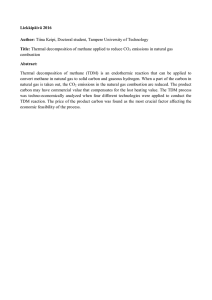Research Journal of Applied Sciences, Engineering and Technology 7(13): 2622-2626,... ISSN: 2040-7459; e-ISSN: 2040-7467
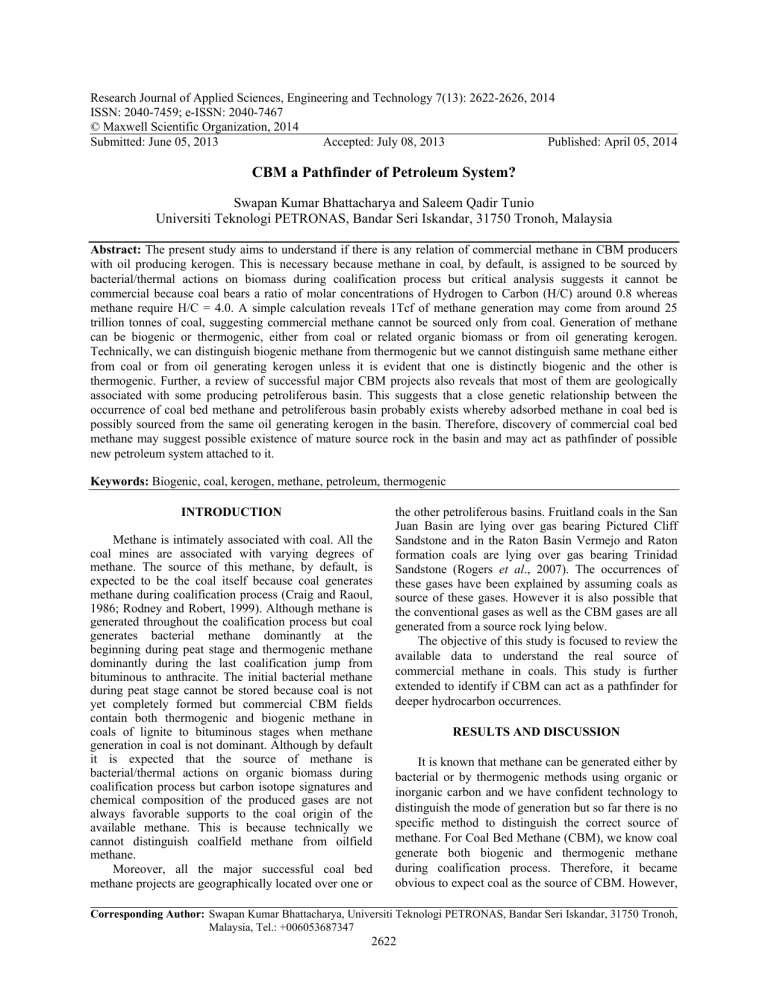
Research Journal of Applied Sciences, Engineering and Technology 7(13): 2622-2626, 2014
ISSN: 2040-7459; e-ISSN: 2040-7467
© Maxwell Scientific Organization, 2014
Submitted: June 05, 2013 Accepted: July 08, 2013 Published: April 05, 2014
CBM a Pathfinder of Petroleum System?
Swapan Kumar Bhattacharya and Saleem Qadir Tunio
Universiti Teknologi PETRONAS, Bandar Seri Iskandar, 31750 Tronoh, Malaysia
Abstract: The present study aims to understand if there is any relation of commercial methane in CBM producers with oil producing kerogen. This is necessary because methane in coal, by default, is assigned to be sourced by bacterial/thermal actions on biomass during coalification process but critical analysis suggests it cannot be commercial because coal bears a ratio of molar concentrations of Hydrogen to Carbon (H/C) around 0.8 whereas methane require H/C = 4.0. A simple calculation reveals 1Tcf of methane generation may come from around 25 trillion tonnes of coal, suggesting commercial methane cannot be sourced only from coal. Generation of methane can be biogenic or thermogenic, either from coal or related organic biomass or from oil generating kerogen.
Technically, we can distinguish biogenic methane from thermogenic but we cannot distinguish same methane either from coal or from oil generating kerogen unless it is evident that one is distinctly biogenic and the other is thermogenic. Further, a review of successful major CBM projects also reveals that most of them are geologically associated with some producing petroliferous basin. This suggests that a close genetic relationship between the occurrence of coal bed methane and petroliferous basin probably exists whereby adsorbed methane in coal bed is possibly sourced from the same oil generating kerogen in the basin. Therefore, discovery of commercial coal bed methane may suggest possible existence of mature source rock in the basin and may act as pathfinder of possible new petroleum system attached to it.
Keywords: Biogenic, coal, kerogen, methane, petroleum, thermogenic
INTRODUCTION
Methane is intimately associated with coal. All the coal mines are associated with varying degrees of methane. The source of this methane, by default, is expected to be the coal itself because coal generates methane during coalification process (Craig and Raoul,
1986; Rodney and Robert, 1999). Although methane is generated throughout the coalification process but coal generates bacterial methane dominantly at the beginning during peat stage and thermogenic methane dominantly during the last coalification jump from bituminous to anthracite. The initial bacterial methane during peat stage cannot be stored because coal is not yet completely formed but commercial CBM fields contain both thermogenic and biogenic methane in coals of lignite to bituminous stages when methane generation in coal is not dominant. Although by default it is expected that the source of methane is bacterial/thermal actions on organic biomass during coalification process but carbon isotope signatures and chemical composition of the produced gases are not always favorable supports to the coal origin of the available methane. This is because technically we cannot distinguish coalfield methane from oilfield methane.
Moreover, all the major successful coal bed methane projects are geographically located over one or the other petroliferous basins. Fruitland coals in the San
Juan Basin are lying over gas bearing Pictured Cliff
Sandstone and in the Raton Basin Vermejo and Raton formation coals are lying over gas bearing Trinidad
Sandstone (Rogers et al ., 2007). The occurrences of these gases have been explained by assuming coals as source of these gases. However it is also possible that the conventional gases as well as the CBM gases are all generated from a source rock lying below.
The objective of this study is focused to review the available data to understand the real source of commercial methane in coals. This study is further extended to identify if CBM can act as a pathfinder for deeper hydrocarbon occurrences.
RESULTS AND DISCUSSION
It is known that methane can be generated either by bacterial or by thermogenic methods using organic or inorganic carbon and we have confident technology to distinguish the mode of generation but so far there is no specific method to distinguish the correct source of methane. For Coal Bed Methane (CBM), we know coal generate both biogenic and thermogenic methane during coalification process. Therefore, it became obvious to expect coal as the source of CBM. However,
Corresponding Author: Swapan Kumar Bhattacharya, Universiti Teknologi PETRONAS, Bandar Seri Iskandar, 31750 Tronoh,
Malaysia, Tel.: +006053687347
2622
Table 1:
Res. J. Appl. Sci. Eng. Technol., 7(13): 2622-2626, 2014
Carbon and hydrogen isotope composition for biogenic and
Gas type thermogenic methane (Hunt, 1979)
δ 13
C
δD isotope instead of stronger
2
D isotope. Table 1 shows distinctive isotope compositions for biogenic and thermogenic methane (Hunt, 1979).
Dry bacterial
Wet thermogenic
Dry thermogenic
-110 to -60
-60 to -30
-40 to -15
-250 to -150
-300 to -120
-150 to -70
Although carbon and hydrogen isotope signatures are common and convincing parameters to distinguish methane being the most stable hydrocarbon, it can be formed by bacterial or thermal process from any organic compound. thermogenic methane from biogenic generation but this does not confirm the source of methane is coal. This is because coal, oil producing kerogen and such other organic matters all can generate methane both by bacterial and thermal means. Identification of the mode of methane generation process is made by carbon and hydrogen isotope compositions in methane (Table 1). Methane generated by biogenic process is lighter in carbon isotope composition because bacteria selectively breaks weaker
12
C-
12
C bonds whereas methane generated by thermogenic process is heavier in isotope composition.
The same is true for hydrogen isotope also. Bacteria selectively use compounds of weaker bonds with
1
H
Data as shown by Rice (1993) is used for review of the genesis of coal bed methane. Available results
(Fig. 1) show methane from the Powder River Basin of
USA is conclusively biogenic whereas San Juan Basin of USA shows thermal genesis and Lr. Silesian Basin of
Poland together with Bowen and Sydney Basins of
Australia show combined influence of bacterial and thermal genesis.
Fig. 1: Modified Whiticar (1996) plot comparing
δ 13
C and
δ 2
D of methane to characterize origin of gas
Fig. 2: Revised Bernard plot after Whiticar (1996) comparing gas wetness and
δ 13
C of methane to characterize origin of gas
2623
Res. J. Appl. Sci. Eng. Technol., 7(13): 2622-2626, 2014
Fig. 3: Revised Bernard plot after Hunt (1979) comparing gas wetness and
δ 13
C of methane to characterize origin of gas
Fig. 4: Schoell’s plot comparing
δ 13
C and
δ 2
D of methane to characterize origin of gas
This is further verified with Bernard plot (Fig. 2) using wettability versus carbon isotope composition. reservoir in San Juan Basin are -42.5. It is therefore confirmed that the isotope signatures, in no way can
Here also samples only from the Powder River Basin matches with biogenic origin of the gas. Gases of San
Juan Basin, USA confirm thermal genesis and Lower
Silesian Basin of Poland together with Bowen Basin justify the genesis of coal bed methane from coal itself.
Although during coalification, methane is generated but critical review suggests as such commercial methane generation from coal is difficult because average molar and Sydney Basins of Australia all suggest gas source from mixed biogenic and thermogenic source.
The above data suggest the gas of coal bed methane is generated either by biogenic or by thermogenic process. The available data of coal bed methane is then plotted in the same way as to characterize methane of the petroleum natural gas. Both
Bernard (Fig. 3) and Schoell plots (Fig. 4) suggests the coal bed methane is in no way different than the natural gases originated in the oil fields. Ridgley et al . (2013) reported in USGS database the average ∂ 13
C for methane in Fruitland coal and Powdercliff sandstone
H/C for coal is around 0.8 whereas molar H/C for methane is 4.0. Preliminary calculation suggests about
25 trillion tones of coal are necessary for generation of
1TCF methane from coal (Appendix 1). Therefore, even if it generates some methane it cannot be commercial because of non-availability of sufficient hydrogen in coal. However, it is possible for coal/organic biomass to generate methane if deficient hydrogen is compensated by water. Kenney et al .
(2002) experimentally showed that free carbon and hydrogen from water catalytically can combine to form
CH
4
. Fischer-Tropsch synthesis also shows similar
2624
Res. J. Appl. Sci. Eng. Technol., 7(13): 2622-2626, 2014
Table 2: List of basins in different countries related to production of CBM and petroleum
Country Basin Remark
United States
United Kingdom
South Africa
Australia
Canada
Appalachian basin
Black warrior basin
Cahaba basin
Cherokee basin
Slater dome basin
Powder river basin
Raton basin
San juan basin
Chesire
Lancashire
Straffordshire
Molteno coal field
Bowen basin
Surat basin
Sydney basin
Telkwa coal field
Western Canadian basin
Petroliferous and CBM producer
Non-petroliferous and non-CBM producer
Petroliferous and CBM producer
Non-petroliferous and non-CBM producer
Petroliferous and CBM producer combination to form petroleum but all these reactions only take place at high temperature and pressure. These do not take place spontaneously in natural conditions.
Moreover, coal generates biogenic methane initially in peat/swamp condition and afterwards by anaerobic methanogens possibly till high volatile bituminous stage of coal. Although it has been claimed that bacterial methane is generated by methanogens coal bed is the same source rock in individual petroliferous basins. Thus occurrence of commercial methane in coal beds indirectly suggests presence of using coal of any maturity (Levine, 1987), it is difficult to accept because methanogens can reduce only low molecular weight carbon compounds. It may however be possible if coal is weathered/fermented and broken down to smaller fragments (Dariusz et al ., 2008).
Trapping of early biogenic methane in coal is difficult because this is generated before proper gelification/coalification process starts. Available biogenic methane in coal is therefore only sourced by anoxic methanogens. Next methane generative stage commences with thermogenic methane that starts generation during late lignite and continues to high petroliferous basin in the deeper horizons.
CONCLUSION
Based on the discussion above it is concluded that methane in producing CBM fields are not generated from the coal. Source of methane is the source rock lying below that produced commercial hydrocarbons in the basin. Coals in such CBM producing basins are acting as reservoir to store methane. Therefore, presence of commercial methane in a coal field is indirect evidence of the presence of matured source volatile bituminous stage whereby methoxy groups from lignins are separated. This cannot be commercial because methoxy group never exceeds 2% of coal
(lignin is available not exceeding 40% in plants of which methoxy group amounts maximum 5%). Finally, during bituminous to anthracite coalification jump (Vro exceed more than 2.0) aromatic condensation reactions dominate to generate some amount of methane.
Thus, methane from coal bed and methane from petroliferous reservoir are indistinguishable. Since all the successful projects are associated with petroliferous basins it is most possible that the source of methane in rock stratigraphically lying below the coal horizons. If some other reservoir rock with suitable trapping conditions lies between the coal bed and the matured source rock then there is every possibility that new hydrocarbon prospects may be discovered. It is therefore concluded that commercial methane in coal bed can be considered as pathfinder for conventional oil field lying in the deeper horizons.
From all of the above discussions it appears that anoxic bacterial methane can be the source of coal bed methane because initial methane cannot be trapped and thermogenic methane cannot be commercial. Results
APPENDIX 1 from the four basins however indicates only Powder
River Basin appear to be of biogenic and others are all mixed thermogenic or pure thermogenic. If bacterial methane is the only source of coal bed methane then commercial methane generation from coal in the other three basins is difficult to explain. Critical review of successful CBM projects further reveals that most of them are geographically lying over producing petroliferous basins (Table 2). Even Powder River
Basin is also associated with petroleum reservoirs.
Calculation of necessary coal for methane generation:
Average compositions:
•
At present molar H/C in coal = 0.8
•
Wood from where coal is formed has molar H/C = 1.4
•
Methane molar H/C = 4.0
This suggests 0.6 moles of hydrogen per mole of carbon has been consumed during coalification. Let us assume all the consumed hydrogen is used for methane generation. Therefore, nearly 7 miles of carbon in coal are needed to supply sufficient hydrogen to make 1 mole of methane.
Now let us calculate the amount of coal necessary for 1Tcf methane generation:
2625
Res. J. Appl. Sci. Eng. Technol., 7(13): 2622-2626, 2014
1mole methane at STP = 22400 cc = 0.791 ft
3
(Assuming it to be ideal)
Therefore, 1ft
3
of methane = 1.264 mole of methane at STP
Therefore, 1Tcf of methane = 1.264×10
12
moles of methane
= 8.82×10
12
moles of carbon
Average coal has 50% moles of carbon suggesting 17.64 trillion moles of coal is necessary to get 1Tcf of methane. Further, average coal has mol. wt = 1.41×10
6
g:
Therefore, 17.64 trillion moles of coal = 17.64×1.41×10
18
g of coal = 24.87×10
12
tonnes of coal
Kenney, J.F., A.K. Vladimir, A.B. Nikolai and
A.A. Vladimir, 2002. The evolution of multicomponent systems at high pressures: VI. The thermodynamic stability of the hydrogen-carbon system: The genesis of hydrocarbons and the origin of petroleum. P. Natl. Acad. Sci. USA, 19(17).
Levine, J.R., 1987. Influence of coal composition on the generation and retention of coal bed natural gas. Proceedings of the 1987 Coal Bed Methane
Symposium, pp: 15-18.
Thus it appears that 1Tcf of methane at STP be generated from
25 trillion tonnes of coal. Rice, D.D., 1993. Compositions and Origins of Coalbed
Gas. In: Law, B.E. and D.D. Rice (Eds.),
ACKNOWLEDGMENT
Hydrocarbon from Coal: AAPG Studies in
Geology 38. Ch. 7, pp: 159-184.
Authors acknowledge financial support of UTP to carry out this research. Authors also acknowledge constant motivation by Dean, Faculty of Geo science
Ridgley, J.L., S.M. Condon and J.R. Hatch, 2013.
Geology and Oil and Gas Assessment of the
Fruitland Total Petroleum System. San Juan Basin, and Petroleum Engineering and support of the Head of
Department to carry out this research work. New Mexico and Colorado. Published as Chapter-6 in USGS Digital Data Series 69-F-6. Retrieved from: pubs.usgs.gov/dds/dds-069/ dds-069-f/ REFERENCES
Craig, T.R. and C. Raoul, 1986. Coal-bed methane and tight gas sands interrelationship. Proceeding of the
REPORTS/chapetr6-508.pdf.
Rodney, H.D.B. and M.L. Robert, 1999. Coal bed methane in wyoming, coal bed methane and the
SG-24 Conference on Geology of Tight Gas
Reservoirs, pp: 110.
Dariusz, S., W.P. Flynn, T. Courtney, S. Irene,
L.M. Jennifer, S.L. Julius, L. Yu-Shih, F.E. Tobias, tertiary geology of the powder river basin.
Proceeding of the 50th Annual Field Conference
Guidebook. Wyoming and Montana, pp: 61-72.
S. Florence, H. Kai-Uwe, M. Maria and S. Arndt,
2008. Methane-producing microbial community in a coal bed of the Illnois Basin. Appl. Environ.
Rogers, R., R. Muthukumarappan, R. Gary and
M. Mike, 2007. Coal Bed Methane-principles and
Practices. 3rd Edn., Oktibbeha Publishing Co.,
Microb., 74(8): 2424-2432.
Hunt, J.M., 1979. Petroleum Geochemistry and
Geology. Ch. 7, 2nd Edn., W.H. Freeman and Co.,
New York, pp: 189.
LLC, Stark Ville, MS., pp: 39-40.
Whiticar, M.J., 1996. Isotope tracking of microbial methane formation and oxidation. Mitt. Internat.
Verein. Limnol., 25: 39-54.
2626



